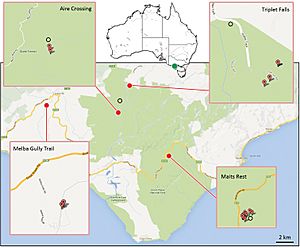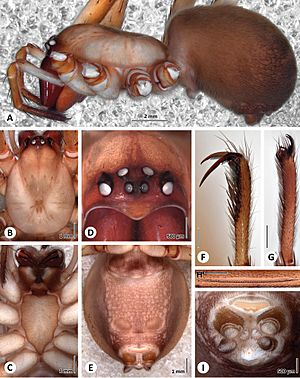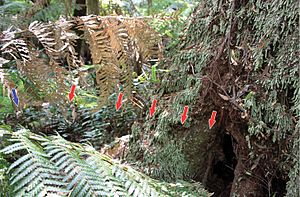Odd-clawed spider facts for kids
Quick facts for kids Odd-clawed spider |
|
|---|---|
 |
|
| P. otwayensis immature male shown holding its catching ladder and assuming a hunting posture | |
| Scientific classification | |
 |
|
| Distribution map of P. otwayensis in the Great Otway National Park of Victoria, Australia. Red marks indicate localities for Michalik et al. (2013); black circles indicate localities given by Milledge (1997). |
The Progradungula otwayensis, also known as the odd-clawed spider, is a special type of spider. It lives only in the Great Otway National Park in Victoria, Australia. This spider is one of only two species in its group, called Progradungula.
Odd-clawed spiders are medium to large in size. Their bodies are about 10 to 15 millimeters (0.4 to 0.6 inches) long. Their legs can spread out to about 72 to 77 millimeters (2.8 to 3.0 inches). They are light in color, from yellowish-brown to light purplish-gray. They have three V-shaped marks on their back. Like other spiders in their family, they have three claws on each leg. These claws are very strong on their first two pairs of legs. They use these claws to grab their prey.
Odd-clawed spiders are ambush predators. This means they wait for their prey instead of chasing it. They build special ladder-shaped webs close to the ground. They hang upside down on these webs, waiting. When prey comes near, they scoop it up into their web to trap it.
Contents
Discovering the Odd-Clawed Spider
An Australian spider expert, Graham A. Milledge, first described the odd-clawed spider in 1997. It was named after the Great Otway National Park. This is where the first spiders were found.
Milledge only found one adult male and some young spiders. The adult female spider was not known until 2013. That's when other spider experts found and described an adult female.
The odd-clawed spider belongs to the spider family called Gradungulidae.
What the Odd-Clawed Spider Looks Like
Odd-clawed spiders have a body made of two main parts. The front part is called the cephalothorax. The back part is called the abdomen.
Female spiders have a carapace (the top of the cephalothorax) that is about 6.92 mm long. Their abdomen is about 8.51 mm long. Their first pair of legs is the longest, about 40.30 mm. The third pair of legs is the shortest.

Male spiders are smaller than females. Their carapace is about 5.42 mm long. Their abdomen is about 5.40 mm long. Like females, their first pair of legs is the longest, about 37.89 mm.
All odd-clawed spiders have three claws on the tips of their legs. The claws on the first two leg pairs are different from each other. They also have stiff hairs under their leg tips. These hairs are very strong on the first two leg pairs. On their fourth pair of legs, they have a short row of fine, comb-like bristles. This is called a calamistrum.
Odd-clawed spiders have eight eyes. They are arranged in two rows of four. The front row curves slightly backward. The back row curves slightly forward. Most of their eyes are white, but the two front middle eyes are black.
Their fangs are strong and point downwards. They have large teeth on the front of their fangs. Females have three teeth, and males have four. They also have very small teeth on the back of their fangs. Males can make sounds with their fangs, but females cannot.
The spider's mouthparts are behind the fangs. They are curved and have jagged edges. These edges help them cut up their prey.
In real life, odd-clawed spiders have a yellowish-brown body. Their mouthparts are reddish-brown. Their legs are also yellowish-brown. Female spiders have three dark brown V-shaped marks on the back half of their abdomen. Male spiders have a light purplish-gray abdomen. They have a pale stripe in the middle of the front half. They also have three paler V-shaped marks on the back half.
Where Odd-Clawed Spiders Live
Odd-clawed spiders live only in the Great Otway National Park in Victoria, Australia. They like to build their webs inside or near hollows in myrtle beech trees (Nothofagus cunninghamii). They especially like very old trees with big hollows.
Sometimes, their webs are found near hollows in mountain ash trees (Eucalyptus regnans). They can also be found at the bottom of tree ferns or even under bridges. However, they mostly prefer myrtle beech trees. This might mean they depend on the special conditions inside these tree hollows.
How Odd-Clawed Spiders Behave

Odd-clawed spiders are nocturnal. This means they are active at night. During the day, they rest inside their hiding spots in tree hollows. About an hour after sunset, they come out to build their webs or hunt.
These spiders are special because they are one of only three species in their family that build snares. Most other spiders in their family are active hunters. Odd-clawed spiders are ambush predators. They build their webs using a special silk from a part called the cribellum. They comb this silk with bristles on their fourth leg pair. This silk is very fine and can easily trap prey without needing glue. Their webs are unique because they are shaped like a ladder.

The main part of their web is a network of support threads. These threads can be up to 2 meters (6.6 feet) above the ground. Two side threads extend from this network down to the ground or plants. The spider builds its ladder-shaped catching web between these two side threads. The catching web is made of loose, zigzagging silk.
The catching web and the support webs are often built far from the spider's hiding spot. They can be up to 3 meters (9.8 feet) away. A single strong thread connects the hiding spot to the webs.
When hunting, the spider sits on its catching ladder with its head pointing down. Its fangs are near the lowest part of the ladder. It uses its third and fourth pairs of legs to hold the ladder behind it. Its first and second pairs of legs are stretched out in front, close to the ground. These front legs help the spider feel vibrations from the ground. These vibrations tell the spider if prey is coming.
When prey is close, the spider lunges forward with its clawed front legs. It scoops the prey into the catching ladder and bites it. The ladder breaks away from its supports and wraps around the prey. The special silk can stretch to hold even large prey. The spider holds the trapped prey and injects it with venom. Once the prey stops moving, the spider starts wrapping it in silk. The catching ladder is destroyed during the capture. The spider might rebuild it before or during its meal.
Odd-clawed spiders also have ways to defend themselves. If there's a small disturbance, they move higher up their web or climb onto a nearby surface. If they feel a bigger threat, they immediately drop from their web to the ground. They then "play dead" by pulling their legs tightly against their bodies and staying still.
Young odd-clawed spiders build their webs and catching ladders only inside tree hollows. They are not found building webs out in the open. This suggests that young spiders live only inside these tree hollows.
Protecting Odd-Clawed Spiders
Odd-clawed spiders depend on myrtle beech trees. Because of this, their survival is closely linked to protecting the places where these trees grow. Their home range is very small, so keeping their habitat safe is important for them to survive.

